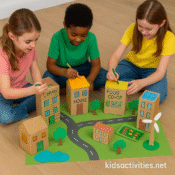
Coding Unplugged – 7 Screen-Free Programming Activities
The Challenge:
While parents want their kids to gain coding literacy, many are hesitant about increasing screen time. How can children build foundational programming skills—without using a tablet or computer?
Why It Works:
Unplugged coding activities teach logic, sequencing, and problem-solving through movement, storytelling, and tactile games. They offer an ideal entry point into computational thinking for both classrooms and living rooms.
Try These 7 Unplugged Coding Activities
1. Human Robot
Give your child a list of commands (turn left, walk forward, pick up) and let them “run” the program. Then let them design one for you!
2. Paper Maze Challenge
Draw a simple maze and write a series of steps using directional arrows. Try debugging the path when it hits an obstacle.
3. Binary Bracelets
Use beads or paper dots to represent 0s and 1s. Convert letters into binary and create name-coded jewellery.
4. Story Algorithms
Pick a familiar task (making toast, brushing teeth). Break it into sequenced steps and rearrange them like a coder.
5. Coding Cubes
Create six-sided dice with commands. Roll them to build unique code sequences and then act them out.
6. Conditionals Tag
Play tag with rules: “If you’re wearing red, you must hop”; “Else, you must crawl.” It’s logic in motion!
7. Debug Dance
Design a simple step-by-step dance routine. “Debug” by correcting missed or out-of-order moves.
The Framework Behind It
- Sequencing: Kids learn order of operations by following and designing step-by-step routines.
- Conditionals: Using “if/then” logic in tag or board games introduces key coding concepts.
- Pattern Recognition: Games build awareness of loops, rules, and repeated structures.
Download Pack
- Step-by-Step Paper Maze Guide
- Printable Binary Decoder Sheet
- Unplugged Activity Tracker (for educators and parents)
Wrap-Up
You don’t need screens to learn coding logic. These activities are playful, hands-on, and build the thinking behind programming—perfect for ages 5–10. Whether you’re a parent, homeschooler, or teacher, you can start coding today using only paper, pencils, and imagination.
Encourage your child to reflect on their favourite activity with a drawing or story—they’ll love revisiting it later.




